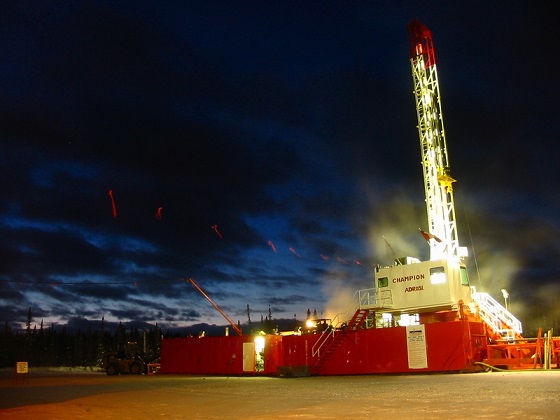Energy
Unlocking Canada’s energy potential

Resource Works CEO and founder Stewart Muir has laid out the conditions for Canada to realize its potential
How can Canada fully realize its energy potential?
Stewart Muir – CEO of Resource Works – often speaks about this question. According to Muir, Canada’s abundant natural resources, skilled workforce, and high standards give us a strong foundation to build on. But to translate these strengths into true economic and environmental leadership, a few key conditions must be met.
Below are five key conditions Muir highlights (especially regarding LNG and oil development) that can help Canada seize its energy opportunity:
Streamlined & Efficient Regulation – Unnecessarily lengthy and unpredictable approval processes have stalled projects and scared away investors. Muir advocates cutting red tape and speeding up decisions so that government isn’t working “at cross purposes” with industry . Reforming Canada’s permitting and regulatory processes would make energy projects more viable and globally competitive, allowing development to proceed faster without compromising standards.
Strong Indigenous Partnerships – Canada’s energy future needs to be built in true partnership with Indigenous peoples. Muir points out that First Nations are increasingly co-leading resource projects, with over 500 economic and reconciliation agreements in British Columbia alone. Embracing Indigenous leadership – through equity partnerships, consultations, and benefit-sharing – not only advances reconciliation but also creates certainty and shared prosperity for energy developments. Projects move forward best when Indigenous communities are on board as genuine partners.
Robust Infrastructure & Market Access – To capitalize on our resources, Canada must expand and modernize the infrastructure that gets energy to market. That means building and upgrading pipelines, ports, and LNG terminals. The recent completion of the Trans Mountain Expansion (TMX) pipeline is a proof point – it’s already moving Canadian oil to U.S. and Asian buyers , helping fetch better prices. Muir and others argue we also need to develop new LNG capacity, including on the East Coast, to supply allies in Europe . By investing in strategic infrastructure, Canada can ensure its oil and gas reach global markets efficiently and safely, turning resource potential into real economic growth.
Proactive Global Market Positioning – Canada has to seize its moment in the global energy market. Demand for energy is skyrocketing worldwide, yet Canada hasn’t fully stepped up to meet it. For example, when allied nations like Germany and Japan turned to Canada for LNG in recent years, they left empty-handed for lack of a “strong business case” to export gas. Meanwhile, other suppliers (the U.S., Qatar, etc.) eagerly filled those needs. Muir emphasizes that Canada must proactively position itself as a reliable exporter – or risk being left behind while others grab the opportunity. That means securing long-term contracts and building trade relationships so Canadian LNG and oil can become go-to choices in Asia, Europe, and beyond. In short, we need to act with urgency on the world stage to claim our share of the market.
Public Confidence through Environmental Leadership – Earning public trust is essential for any energy project to succeed. Canadians need to see that resource development can coexist with high environmental standards and climate responsibility. Muir notes that strengthening public confidence in energy and mining projects could help “preserve and unlock” the economic value of Canada’s huge reserves, and even position Canada as a leader in how to do resource development right. This means being transparent, engaging communities early, and upholding world-class environmental protections. Canada’s own track record shows that responsible resource development is not just possible – “it’s our forte”. By leading with strong environmental performance (for instance, using clean technology and cutting emissions per barrel), project developers can build the social license to operate. In turn, this public trust enables more projects to move ahead, aligning economic growth with our climate and environmental commitments.
Bottom Line: Muir’s vision suggests that if Canada delivers on these conditions – from faster approvals and better partnerships to smarter infrastructure and trust-building – we can translate our natural advantages into both prosperity and sustainability. Canada has the resources and know-how; now it’s about having the will to act.
By focusing on these key areas, Canada can become not only an energy powerhouse at home, but also a global example of economic and environmental leadership in responsible energy development.
Alberta
Alberta Premier Danielle Smith Discusses Moving Energy Forward at the Global Energy Show in Calgary

From Energy Now
At the energy conference in Calgary, Alberta Premier Danielle Smith pressed the case for building infrastructure to move provincial products to international markets, via a transportation and energy corridor to British Columbia.
“The anchor tenant for this corridor must be a 42-inch pipeline, moving one million incremental barrels of oil to those global markets. And we can’t stop there,” she told the audience.
The premier reiterated her support for new pipelines north to Grays Bay in Nunavut, east to Churchill, Man., and potentially a new version of Energy East.
The discussion comes as Prime Minister Mark Carney and his government are assembling a list of major projects of national interest to fast-track for approval.
Carney has also pledged to establish a major project review office that would issue decisions within two years, instead of five.
Alberta
Punishing Alberta Oil Production: The Divisive Effect of Policies For Carney’s “Decarbonized Oil”

From Energy Now
By Ron Wallace
The federal government has doubled down on its commitment to “responsibly produced oil and gas”. These terms are apparently carefully crafted to maintain federal policies for Net Zero. These policies include a Canadian emissions cap, tanker bans and a clean electricity mandate.
Following meetings in Saskatoon in early June between Prime Minister Mark Carney and Canadian provincial and territorial leaders, the federal government expressed renewed interest in the completion of new oil pipelines to reduce reliance on oil exports to the USA while providing better access to foreign markets. However Carney, while suggesting that there is “real potential” for such projects nonetheless qualified that support as being limited to projects that would “decarbonize” Canadian oil, apparently those that would employ carbon capture technologies. While the meeting did not result in a final list of potential projects, Alberta Premier Danielle Smith said that this approach would constitute a “grand bargain” whereby new pipelines to increase oil exports could help fund decarbonization efforts. But is that true and what are the implications for the Albertan and Canadian economies?
The federal government has doubled down on its commitment to “responsibly produced oil and gas”. These terms are apparently carefully crafted to maintain federal policies for Net Zero. These policies include a Canadian emissions cap, tanker bans and a clean electricity mandate. Many would consider that Canadians, especially Albertans, should be wary of these largely undefined announcements in which Ottawa proposes solely to determine projects that are “in the national interest.”
The federal government has tabled legislation designed to address these challenges with Bill C-5: An Act to enact the Free Trade and Labour Mobility Act and the Building Canada Act (the One Canadian Economy Act). Rather than replacing controversial, and challenged, legislation like the Impact Assessment Act, the Carney government proposes to add more legislation designed to accelerate and streamline regulatory approvals for energy and infrastructure projects. However, only those projects that Ottawa designates as being in the national interest would be approved. While clearer, shorter regulatory timelines and the restoration of the Major Projects Office are also proposed, Bill C-5 is to be superimposed over a crippling regulatory base.
It remains to be seen if this attempt will restore a much-diminished Canadian Can-Do spirit for economic development by encouraging much-needed, indeed essential interprovincial teamwork across shared jurisdictions. While the Act’s proposed single approval process could provide for expedited review timelines, a complex web of regulatory processes will remain in place requiring much enhanced interagency and interprovincial coordination. Given Canada’s much-diminished record for regulatory and policy clarity will this legislation be enough to persuade the corporate and international capital community to consider Canada as a prime investment destination?
As with all complex matters the devil always lurks in the details. Notably, these federal initiatives arrive at a time when the Carney government is facing ever-more pressing geopolitical, energy security and economic concerns. The Organization for Economic Co-operation and Development predicts that Canada’s economy will grow by a dismal one per cent in 2025 and 1.1 per cent in 2026 – this at a time when the global economy is predicted to grow by 2.9 per cent.
It should come as no surprise that Carney’s recent musing about the “real potential” for decarbonized oil pipelines have sparked debate. The undefined term “decarbonized”, is clearly aimed directly at western Canadian oil production as part of Ottawa’s broader strategy to achieve national emissions commitments using costly carbon capture and storage (CCS) projects whose economic viability at scale has been questioned. What might this mean for western Canadian oil producers?
The Alberta Oil sands presently account for about 58% of Canada’s total oil output. Data from December 2023 show Alberta producing a record 4.53 million barrels per day (MMb/d) as major oil export pipelines including Trans Mountain, Keystone and the Enbridge Mainline operate at high levels of capacity. Meanwhile, in 2023 eastern Canada imported on average about 490,000 barrels of crude oil per day (bpd) at a cost estimated at CAD $19.5 billion. These seaborne shipments to major refineries (like New Brunswick’s Irving Refinery in Saint John) rely on imported oil by tanker with crude oil deliveries to New Brunswick averaging around 263,000 barrels per day. In 2023 the estimated total cost to Canada for imported crude oil was $19.5 billion with oil imports arriving from the United States (72.4%), Nigeria (12.9%), and Saudi Arabia (10.7%). Since 1988, marine terminals along the St. Lawrence have seen imports of foreign oil valued at more than $228 billion while the Irving Oil refinery imported $136 billion from 1988 to 2020.
What are the policy and cost implication of Carney’s call for the “decarbonization” of western Canadian produced, oil? It implies that western Canadian “decarbonized” oil would have to be produced and transported to competitive world markets under a material regulatory and financial burden. Meanwhile, eastern Canadian refiners would be allowed to import oil from the USA and offshore jurisdictions free from any comparable regulatory burdens. This policy would penalize, and makes less competitive, Canadian producers while rewarding offshore sources. A federal regulatory requirement to decarbonize western Canadian crude oil production without imposing similar restrictions on imported oil would render the One Canadian Economy Act moot and create two market realities in Canada – one that favours imports and that discourages, or at very least threatens the competitiveness of, Canadian oil export production.
Ron Wallace is a former Member of the National Energy Board.
-

 National2 days ago
National2 days agoCarney promotes MP instrumental in freezing Freedom Convoy donors’ bank accounts
-

 Business2 days ago
Business2 days agoThe carbon tax’s last stand – and what comes after
-

 conflict1 day ago
conflict1 day agoIran nuclear talks were ‘coordinated deception’ between US and Israel: report
-

 illegal immigration2 days ago
illegal immigration2 days agoLA protests continue as judge pulls back CA National Guard ahead of ‘No Kings Day’
-

 conflict2 days ago
conflict2 days agoIsrael strikes Iran, targeting nuclear sites; U.S. not involved in attack
-

 International1 day ago
International1 day agoIsrael’s Decapitation Strike on Iran Reverberates Across Global Flashpoints
-

 Energy1 day ago
Energy1 day agoCanada is no energy superpower
-

 Alberta1 day ago
Alberta1 day agoPunishing Alberta Oil Production: The Divisive Effect of Policies For Carney’s “Decarbonized Oil”




